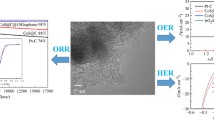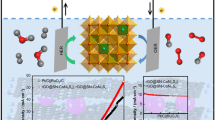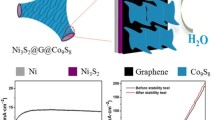Abstract
Hydrogen evolution reaction (HER) by electrochemical water splitting using new promising non-precious metal catalysts shows great potential for clean energy technology. The design and fabrication of a high-performance electrode material based on cobalt disulfide/reduced graphene oxide (CoS2/RGO) nanocomposites is reported by a one-step hydrothermal method. Benefiting from its structural advantages, namely, large amount of exposed surface, fast charge transfer, and synergistic effect between CoS2 and RGO, the as-prepared nanocomposites are exploited as a catalyst for the HER. The results indicate that CoS2/RGO-5 % exhibits the best performance of hydrogen evolution and the smallest overpotential of 159 mV to achieve a 15 mA cm−2 current density, possessing the easiest releasing of hydrogen gas and the highest charge transfer rate, as well as remarkable stability.
Similar content being viewed by others
Background
Hydrogen, as a new type of renewable energy source, has attracted extensive concern due to its potential application in powering vehicles or electric devices. A promising method to produce hydrogen is electrocatalytic reduction of water via the hydrogen evolution reaction (HER) [1–3]. The platinum catalysts exhibit extraordinary activity in catalyzing the hydrogen evolution, but the high cost and scarcity seriously impede their practical applications. These limitations prompt the intensive investigations on inexpensive and earth-abundant electrocatalysts, e.g., metal sulfide [4], carbide [5], boride [6], and phosphide [7]. Many efforts have been taken to synthesize inorganic metal sulfur complexes to create analogs to these active materials. Particularly, MoS2 and WS2 have been researched as HER catalysts for their lower cost and higher stability than other metal derivatives [8–10]. On the other hand, carbon materials with excellent electrical conductivity, such as carbon nanotube and active carbons, were generally applied as supports of HER catalysts to enhance their stability and electrical conductivity [11]. Till now, only few reports were devoted to the study of 2D CoS2/graphene catalysts, which can expand the category of catalytic materials fitting for efficient HER [12].
Herein, we report a novel strategy to synthesize 2D cobalt disulfide/reduced graphene oxide (CoS2/RGO) nanocomposites with high HER activity by a hydrothermal method. In these nanocomposites, RGO serves as a matrix for the uniform growth of CoS2 nanoclusters. The presence of RGO facilitates both electrical conductivity and ionic transportation during the HER. Besides, the homogeneous dispersion of CoS2 nanoclusters on the surface of RGO could also incredibly increases the catalytic active sites [13]. Furthermore, the interaction between graphene and CoS2 can also inhibit the aggregation of CoS2 nanoclusters, resulting in improved cycling stability [14]. Benefiting from their high electrical conductivity, opened pore structure, excellent dispersion of CoS2, and positive synergistic effect between CoS2 and RGO, the CoS2/RGO nanocomposites exhibit excellent performance for HER process.
Methods
Materials
Natural graphite was provided by Qingdao Ruisheng Graphite Company. Cobalt(II) acetate tetrahydrate (Co(Ac)2·4H2O), thiourea (H2NCSNH2), ethyl alcohol, hydrogen peroxide (H2O2), potassium permanganate (KMnO4), concentrated sulphuric acid (H2SO4), and sodium nitrate (NaNO3) were purchased from Sinopharm Chemical Reagent Company and used without further purification. Nafion (5 wt%) water solution was purchased from Shanghai Yibang Technology Co., Ltd. Deionized water (DI) was prepared by a Millipore pure water system.
GO Preparation and Purification
GO was synthesized by using modified Hummer’s method. In a typical synthesis, 1 g of graphite, 1 g of NaNO3, and 46 mL of H2SO4 were firstly mixed together in ice bath. Afterwards, 6 g of KMnO4 was added, and the suspension was heated to 35 °C. After vigorous stirring for 60 min, 80 mL of deionized water was added, and the temperature of solution was heated to 95 °C. Finally, 200 mL of water and 6 mL of H2O2 (30 wt%) was dropped into the solution, turning the color from dark brown to light yellow. Afterwards, the solution was filtered and washed thoroughly with deionized water. The filter cake was redispersed in water by strong mechanical agitation. After that, centrifugation was performed at 1500 rpm for four times until the solution is free of any visible particles. The supernatant was centrifuged at 8000 rpm for 20 min to remove tiny GO pieces. Finally, the precipitate was then redispersed in certain amount of water by sonication, resulting in an exfoliated GO solution (1 mg mL−1).
Synthesis of CoS2/RGO Nanosheets
Co(Ac)2·4H2O (0.01 mol) and H2NCSNH2 (0.02 mol) were added to 60 mL of GO solution (containing 12.3 mg GO that is weighed by drying the GO solution). The mixture was then treated by sonication for about 30 min, giving a clear solution. Then, the solution was poured to a Teflon-lined autoclave (100 mL) and heated in an oven at 180 °C for 12 h. During this hydrothermal process, the GO was reduced to RGO. After being cooled to an ambient temperature, the resultant was separated by centrifugation, then washed with water and ethanol several times, and finally dried in an oven at 60 °C. For comparison, different GO dosages (36.9, 61.5, and 184.5 mg) were adopted in the preparation. The CoS2/RGO composites were denoted as CoS2/GO-X (X = 1, 3, 5, 15 %), where X is the mass ratio of GO and CoS2. Pure CoS2 was also synthesized under the same conditions in the absence of GO.
Material Characterizations
The morphology of the CoS2/RGO nanosheets was observed by field emission scanning electron microscope (SEM, FEI Sirion 200) and transmission electron microscope (TEM, JEM 2010, JEOL, Japan). Crystal phase analysis was performed on a PANalytical X-ray diffractometer (XRD). Nitrogen sorption isotherms were determined at 77 K using a porosity analyzer (Tristar 3000, Micromeritics, USA). The Brunauer-Emmett-Teller (BET) area of the samples was obtained using the adsorption branch within the relative pressure (P/P 0) ranging from 0.06 to 0.3. Pore size distribution (PSD) curve was obtained from the desorption branch by the BJH (Barrett-Joyner-Halenda) method.
Electrochemical Measurements
All electrochemical studies were conducted on a CHI660D electrochemical work station in a three-electrode setup using the as-prepared samples as working electrode, a calomel electrode as the reference electrode, and a platinum foil as a counter electrode in 0.5 M H2SO4 electrolyte. The oxygen dissolved in the electrolyte was removed by purging with nitrogen for 10 min prior to the experiments. Linear sweep voltammetry was used to determine the electrocatalytic activities of the as-prepared samples (with an active area of 0.5 cm2) towards the HER at room temperature. HER measurement was also performed using a carbon counter electrode to preclude any Pt contamination. The results showed that the polarization curves from either counter electrode are almost the same. All the potentials were referred to the reversible hydrogen electrode (RHE) without specification.
Results and Discussion
The strategy for the synthesis of the CoS2/RGO nanosheets is illustrated in Fig. 1. CoS2 nanoclusters were in situ grown on the RGO surface through a facile hydrothermal process. In the structure of CoS2/RGO nanocomposites, the highly conductive graphene and the 2D structure of the composites are beneficial for electron transfer and proton transport, respectively. This is supposed to facilitate the proton reduction at the catalyst/electrolyte interface. Besides, the high dispersion of CoS2 nanoclusters on the surface of graphene will increase drastically the catalytic active sites for the hydrogen evolution reactions [15–17].
As shown in Fig. 2a–d, CoS2 nanoclusters grow uniformly on both sides of the graphene sheets with a size of several micrometers, and the size of nanoclusters is about 50–80 nm. It also can be found from Fig. 2e–h that the morphology of CoS2 nanoclusters changes from vertically dispersed nanosheets to uniformly distributed nanoparticles with the increase of GO dosage. This is because the amount of CoS2 is only enough to form crystal nucleuses at the large dosage of GO. Higher GO dosage would be beneficial for better dispersion of CoS2 nanoclusters, contributing to more exposed CoS2 surface for HER. The high-resolution TEM images demonstrate that most of the CoS2 nanosheets stand vertically on graphene for CoS2/RGO-1 % sample (Fig. 3a, b). When the GO dosage was increased to 5 wt%, the shape of CoS2 turns from nanosheets to nanoparticles. (Fig. 3c, d). The SEM and TEM observations agree with each other.
The crystal phase of the CoS2/RGO composites was detected by X-ray diffraction, as is presented in Fig. 4. It is shown that all the peaks are attributed to the cubic CoS2 phase (JCPDS number 41-1471), which should be an active phase for HER. The peak intensity decreases with the rise of GO dosage because of better dispersion of CoS2 on more RGO. No diffraction peaks for RGO can be hardly detected in the spectrum due to its low content.
The pore texture of the as-prepared samples was determined by nitrogen sorption measurement at 77 K. As shown in Fig. 5a, all the CoS2/RGO nanocomposites show typical type IV isotherm and obvious hysteresis loop, revealing their mesoporous nature. The BET specific surface area of CoS2/RGO-5 % is 26.2 m2g−1 (Table 1), which is the highest among these samples. The larger porosity of CoS2/RGO-5 % sample is also manifested by the PSD curves in Fig. 5b. The large surface area and pore volume are also supposed to facilitate its catalytic activity to HER.
The as-prepared CoS2/RGO catalyst coated on glassy carbon was applied as a working electrode for the HER. Pure CoS2 was also evaluated for comparison. As shown in Fig. 6a, the polarization curves is measured in 0.5 M H2SO4 electrolyte with a voltage sweep rate of 5 mV s−1. The polarization curve of CoS2/RGO-5 % sample shows a small overpotential of 143, 173, and 346 mV at the current densities of 10, 20, and 100 mA cm−2, respectively, indicating a good HER activity. In contrast, pure CoS2 exhibits overpotential of 414 mV at a current density of 20 mA cm−2, which is apparently larger than the overpotential detected for CoS2/RGO composites, suggesting its worse HER activity. On the other hand, at the potential of 300 mV, the CoS2/RGO-5 % shows a large cathodic current density of 78.8 mA cm−2 which is about nine times that of the CoS2/RGO-1 % electrode (9.0 mA cm−2) and far larger than the pure CoS2 electrode (6.0 mA cm−2). The Tafel slope of CoS2/RGO-5 % in Fig. 6b is 285 mV dec−1, thus leading to a faster increment of the HER rate with increasing overpotential. The polarization curve recorded on CoS2/RGO-5 % displays the lowest overpotential of 159 mV to get a 15 mA cm−2 current density (Fig. 6c), which is smaller than those of the other samples. Therefore, the CoS2/RGO-5 % with the smallest slope shows the highest activity in the HER. The excellent catalytic performance of CoS2/RGO-5 % is due to its large surface area, which leads to high dispersion of CoS2 nanoparticles and more active sites. Compared with pure CoS2, the better performance of CoS2/RGO composites (1, 3, 5 %) also indicates the positive synergistic effect between CoS2 and RGO for HER.
To evaluate the stability of the CoS2/RGO-5 % catalyst, the electrode is operated continuously for 500 cycles of potential scans (scan rate 5 mV s−1). The results show that there is no apparent recession of the activity, demonstrating robust catalytic durability of the CoS2/RGO-5 % catalyst in acidic electrolyte (Fig. 6d). This should be attributed to the interaction between CoS2 and RGO, which stabilize the CoS2 nanoparticles in HER process.
Conclusions
In conclusion, we have proposed a novel method to synthesize active CoS2/RGO nanocomposites by hydrothermal treatment. The obtained sample can be employed as a catalytic material for the hydrogen evolution reactions. The synergistic effect of CoS2 and RGO contributes to the good HER activity of these nanocomposites. Besides, this effective synthesis method could be extended to manufacture more promising electrode materials for fuel cell, Li-ion or Na-ion batteries, and supercapacitors.
References
Zou X, Zhang Y (2015) Noble metal-free hydrogen evolution catalysts for water splitting. Chem Soc Rev 44:5148–5180
Morales-Guio CG, Stern LA, Hu X (2014) Nanostructured hydrotreating catalysts for electrochemical hydrogen evolution. Chem Soc Rev 43:6555–6569
Chen WF, Muckerman JT, Fujita E (2013) Recent developments in transition metal carbides and nitrides as hydrogen evolution electrocatalysts. Chem Commun 49:8896–8909
Long X, Li GX, Wang ZL, Zhu HY, Zhang T, Xiao S, Guo WY, Yang SH (2015) Metallic iron-nickel sulfide ultrathin nanosheets as a highly active electrocatalyst for hydrogen evolution reaction in acidic media. J Am Chem Soc 137:11900–11903
Ma FX, Wu HB, Xia BY, Xu CY, Lou XW (2015) Hierarchical β-Mo2C nanotubes organized by ultrathin nanosheets as a highly efficient electrocatalyst for hydrogen production. Angew Chem Int Ed 54:1–6
Xie JF, Li S, Zhang XD, Zhang JJ, Wang RX, Zhang H, Pan BC, Xie Y (2014) Atomically-thin molybdenum nitride nanosheets with exposed active surface sites for efficient hydrogen evolution. Chem Sci 5:4615–4620
Xiao P, Sk MA, Thia L, Ge XM, Lim RJ, Wang JY, Lim KH, Wang X (2014) Molybdenum phosphide as an efficient electrocatalyst for the hydrogen evolution reaction. Energy Environ Sci 7:2624–2629
Zhu H, Lyu FL, Du ML, Zhang M, Wang QF, Yao JM, Guo BC (2014) Design of two-dimensional, ultrathin MoS2 nanoplates fabricated within one-dimensional carbon nanofibers with thermosensitive morphology: high-performance electrocatalysts for the hydrogen evolution reaction. ACS Appl Mater Inter 6:22126–22137
Liang HF, Li LS, Meng F, Dang LN, Zhuo JQ, Forticaux A, Wang ZC, Jin S (2015) Porous two-dimensional nanosheets converted from layered double hydroxides and their applications in electrocatalytic water splitting. Chem Mater 27:5702–5711
Zhu H, Du ML, Zhang M, Zou ML, Yang TT, Fu YQ, Yao JM (2014) The design and construction of 3D rose-petal-shaped MoS2 hierarchical nanostructures with structure-sensitive properties. J Mater Chem A 2:7680–7685
Sun Y, Cui H, Jin SX, Wang CX (2012) Eutectic solidification applied to nanofabrication: a strategy to prepare large-scale tungsten carbide nanowalls. J Mater Chem 22:16566–16571
Duan XL, Gao ZY, Chang JL, Wu DP, Ma PF, He JJ, Xu F, Gao SY, Jiang K (2013) CoS2-graphene composite as efficient catalytic counter electrode for dye-sensitized solar cell. Electrochim Acta 114:173–179
Ma FX, Hu H, Wu HB, Xu CY, Xu ZC, Zhen L (2015) Formation of uniform Fe3O4 hollow spheres organized by ultrathin nanosheets and their excellent lithium storage properties. Adv Mater 27:4097–4101
Qi J, Lai XY, Wang JY, Tang HJ, Ren H, Yang Y, Jin Q, Zhang LJ, Yu RB, Ma GH (2015) Multi-shelled hollow micro-/nanostructures. Chem Soc Rev 44:6749–6773
Greeley J, Jaramillo TF, Bonde J, Chorkendorff IB, Nørskov JK (2006) Computational high-throughput screening of electrocatalytic materials for hydrogen evolution. Nat Mater 5:909–913
Wang HY, Lu ZY, Kong DD, Sun J, Hymel TM, Cui Y (2014) Electrochemical tuning of MoS2 nanoparticles on three-dimensional substrate for efficient hydrogen evolution. ACS Nano 8:4940–4947
Sun YJ, Liu C, Grauer DC, Yano JK, Long JR, Yang PD, Chang CJ (2013) Electrodeposited cobalt-sulfide catalyst for electrochemical and photo electrochemical hydrogen generation from water. J Am Chem Soc 135:17699–17702
Acknowledgements
This work was financially supported by the National Natural Science Foundation of China (21476264, 51107076), the Distinguished Young Scientist Foundation of Shandong Province (JQ201215), the Taishan Scholar Foundation (ts20130929), and the Fundamental Research Funds for the Central Universities (15CX05029A, 15CX08009A).
Author information
Authors and Affiliations
Corresponding authors
Additional information
Competing Interests
The authors declare that they have no competing interests.
Authors’ Contributions
WX synthesized the nanocomposites materials and drafted part of the manuscript. YZ conducted the electrochemical assessment of the materials. QX participated in the design of the study and discussion of the results. ZY conceived of the study, participated in its design and coordination, and helped to draft the manuscript. All authors read and approved the final manuscript.
Rights and permissions
Open Access This article is distributed under the terms of the Creative Commons Attribution 4.0 International License (http://creativecommons.org/licenses/by/4.0/), which permits unrestricted use, distribution, and reproduction in any medium, provided you give appropriate credit to the original author(s) and the source, provide a link to the Creative Commons license, and indicate if changes were made.
About this article
Cite this article
Xing, W., Zhang, Y., Xue, Q. et al. Highly Active Catalyst of Two-Dimensional CoS2/Graphene Nanocomposites for Hydrogen Evolution Reaction. Nanoscale Res Lett 10, 488 (2015). https://doi.org/10.1186/s11671-015-1198-3
Received:
Accepted:
Published:
DOI: https://doi.org/10.1186/s11671-015-1198-3










